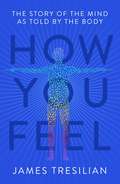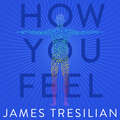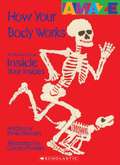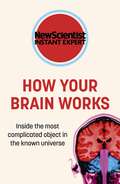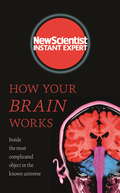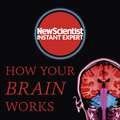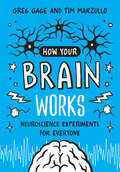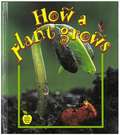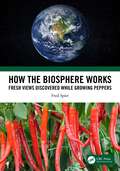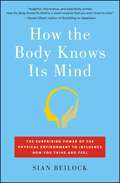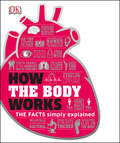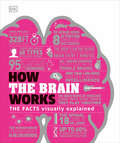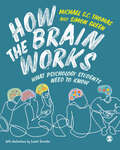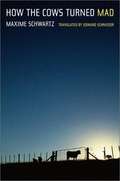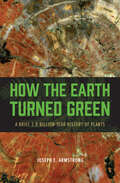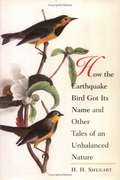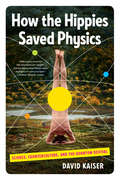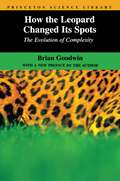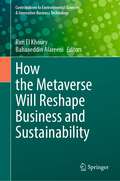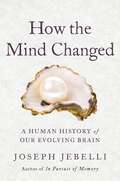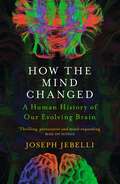- Table View
- List View
How You Feel: The Story of the Mind as Told by the Body
by James TresilianClose your eyes and ask yourself, 'what do I feel?'You might feel thirsty or tired. You might feel healthy and well or perhaps a little under the weather. Maybe you can feel that you are standing or that you are leaning over. You may also feel the world around you - the shape and texture of an apple in your hand, the feel of a chair you're sitting on.All these feelings have something in common, say psychologists and neuroscientists. They are all mental events, things that happen in the mind. But what if this is all wrong?What if it's not just the mind, but also the body itself that feels? And not merely physical sensations, but other feelings that seem to have nothing to do with bodies. Things like 'emotions' and 'intuitions' - joy or rage, anxiety or optimism, or the feeling of being hard done by or misunderstood?Drawing on the latest research and a range of classic and contemporary thought, How You Feel shows you that your brain and your body are two parts of a single system that creates your mind and mental life. You will discover that you don't have feelings, thoughts and emotions inside your body, you have them with your body. There can be no mind without the body.Psychology is no longer about the brain, or about 'mind and body', it is about the whole that is you.
How You Feel: The Story of the Mind as Told by the Body
by James TresilianClose your eyes and ask yourself, ''what do I feel?''You might feel thirsty or tired. You might feel healthy and well or perhaps a little under the weather. Maybe you can feel that you are standing or that you are leaning over. You may also feel the world around you - the shape and texture of an apple in your hand, the feel of a chair you''re sitting on.All these feelings have something in common, say psychologists and neuroscientists. They are all mental events, things that happen in the mind. But what if this is all wrong?What if it''s not just the mind, but also the body itself that feels? And not merely physical sensations, but other feelings that seem to have nothing to do with bodies. Things like ''emotions'' and ''intuitions'' - joy or rage, anxiety or optimism, or the feeling of being hard done by or misunderstood?Drawing on the latest research and a range of classic and contemporary thought, How You Feel shows you that your brain and your body are two parts of a single system that creates your mind and mental life. You will discover that you don''t have feelings, thoughts and emotions inside your body, you have them with your body. There can be no mind without the body.Psychology is no longer about the brain, or about ''mind and body'', it is about the whole that is you.
How You Feel: The Story of the Mind as Told by the Body
by James TresilianClose your eyes and ask yourself, 'what do I feel?'You might feel thirsty or tired. You might feel healthy and well or perhaps a little under the weather. Maybe you can feel that you are standing or that you are leaning over. You may also feel the world around you - the shape and texture of an apple in your hand, the feel of a chair you're sitting on.All these feelings have something in common, say psychologists and neuroscientists. They are all mental events, things that happen in the mind. But what if this is all wrong?What if it's not just the mind, but also the body itself that feels? And not merely physical sensations, but other feelings that seem to have nothing to do with bodies. Things like 'emotions' and 'intuitions' - joy or rage, anxiety or optimism, or the feeling of being hard done by or misunderstood?Drawing on the latest research and a range of classic and contemporary thought, How You Feel shows you that your brain and your body are two parts of a single system that creates your mind and mental life. You will discover that you don't have feelings, thoughts and emotions inside your body, you have them with your body. There can be no mind without the body.Psychology is no longer about the brain, or about 'mind and body', it is about the whole that is you.
How Your Body Works: A Good Look Inside Your Insides
by David StewartWhat, Why, and How is explained with respect to human body.
How Your Brain Works: Inside The Most Complicated Object In The Universe (New Scientist Instant Expert Ser. #41)
by Caroline WilliamsEver wondered what's going on inside your head? The brain has long been a source of fascination. In 1819, the radical thinker and surgeon William Lawrence put it like this: "It is strongly suspected that a Newton or Shakespeare excels other mortals only... by having an extra inch of brain in the right place." Today, many such suspicions are certainties. We understand the structures of the brain, minor and major, and their roles in making us who we are. We can record electrical signals from individual brain cells or networks of them. Imaging technology lets us see both snapshots of the brain and also videos of it in action. We can follow connections within the brain and watch them reform after an injury. How Your Brain Works explores what's going on inside your head, and what makes you, you. It looks at techniques for controlling the brain using electric and magnetic fields, as well as investigating the latest technologies that allow you to control the outside world using your mind alone.
How Your Brain Works: Inside the most complicated object in the known universe
by New ScientistEver wondered what's going on inside your head?You are your brain. Everything that makes you you, and all your experiences of the world, are somehow conjured up by 1.4 kilograms of grey matter inside your skull. That might seem impossible, but science has advanced so much that we now understand not just its structures and inner workings but also how it can give rise to perception, consciousness, emotions, memories, intelligence, sleep and more. HOW YOUR BRAIN WORKS explores the amazing world inside your head. Discover the evolution and anatomy of the brain. Learn how we can peer inside it and watch it at work, and how the latest technology can allow us to control our minds and those of others. ABOUT THE SERIESNew Scientist Instant Expert books are definitive and accessible entry points to the most important subjects in science; subjects that challenge, attract debate, invite controversy and engage the most enquiring minds. Designed for curious readers who want to know how things work and why, the Instant Expert series explores the topics that really matter and their impact on individuals, society, and the planet, translating the scientific complexities around us into language that's open to everyone, and putting new ideas and discoveries into perspective and context.
How Your Brain Works: Inside the most complicated object in the known universe (New Scientist Instant Expert)
by New ScientistEver wondered what's going on inside your head?You are your brain. Everything that makes you you, and all your experiences of the world, are somehow conjured up by 1.4 kilograms of grey matter inside your skull. That might seem impossible, but science has advanced so much that we now understand not just its structures and inner workings but also how it can give rise to perception, consciousness, emotions, memories, intelligence, sleep and more. HOW YOUR BRAIN WORKS explores the amazing world inside your head. Discover the evolution and anatomy of the brain. Learn how we can peer inside it and watch it at work, and how the latest technology can allow us to control our minds and those of others. ABOUT THE SERIESNew Scientist Instant Expert books are definitive and accessible entry points to the most important subjects in science; subjects that challenge, attract debate, invite controversy and engage the most enquiring minds. Designed for curious readers who want to know how things work and why, the Instant Expert series explores the topics that really matter and their impact on individuals, society, and the planet, translating the scientific complexities around us into language that's open to everyone, and putting new ideas and discoveries into perspective and context.
How Your Brain Works: Inside the most complicated object in the known universe (New Scientist Instant Expert)
by New ScientistIn How Your Brain Works leading neuroscientists and New Scientist introduce the evolution and anatomy of the brain viewed through traits such as: memory, emotions, sleep, sensing and perception.Ever wondered what's going on inside your head?You are your brain. Everything that makes you you, and all your experiences of the world, are somehow conjured up by 1.4 kilograms of grey matter inside your skull. That might seem impossible, but science has advanced so much that we now understand not just its structures and inner workings but also how it can give rise to perception, consciousness, emotions, memories, intelligence, sleep and more. HOW YOUR BRAIN WORKS explores the amazing world inside your head. Discover the evolution and anatomy of the brain. Learn how we can peer inside it and watch it at work, and how the latest technology can allow us to control our minds and those of others. ABOUT THE SERIESNew Scientist Instant Expert books are definitive and accessible entry points to the most important subjects in science; subjects that challenge, attract debate, invite controversy and engage the most enquiring minds. Designed for curious readers who want to know how things work and why, the Instant Expert series explores the topics that really matter and their impact on individuals, society, and the planet, translating the scientific complexities around us into language that's open to everyone, and putting new ideas and discoveries into perspective and context.(P) 2017 Hodder & Stoughton Limited
How Your Brain Works: Neuroscience Experiments for Everyone
by Greg Gage Tim MarzulloDiscover the hidden electrical world inside your nervous system using DIY, hands-on experiments, for all ages. No MD or PhD required!The workings of the brain are mysterious: What are neural signals? What do they mean? How do our senses really sense? How does our brain control our movements? What happens when we meditate? Techniques to record signals from living brains were once thought to be the realm of advanced university labs . . . but not anymore! This book allows anyone to participate in the discovery of neuroscience through hands-on experiments that record the hidden electrical world beneath our skin and skulls. In How Your Brain Works, neuroscientists Greg Gage and Tim Marzullo offer a practical guide—accessible and useful to readers from middle schoolers to college undergraduates to curious adults—for learning about the brain through hands-on experiments. Armed with some DIY electrodes, readers will get to see what brain activity really looks like through simple neuroscience experiments. Written by two neuroscience researchers who invented open-source techniques to record signals from neurons, muscles, hearts, eyes, and brains, How Your Brain Works includes more than forty-five experiments to gain a deeper understanding of your brain. Using a homemade scientific instrument called a SpikerBox, readers can see how fast neural signals travel by recording electrical signals from an earthworm. Or, turning themselves into subjects, readers can strap on some electrode stickers to detect the nervous system in their own bodies. Each chapter begins by describing some phenomenology of a particular area of neuroscience, then guides readers step-by-step through an experiment, and concludes with a series of open-ended questions to inspire further investigation. Some experiments use invertebrates (such as insects), and the book provides a thoughtful framework for the ethical use of these animals in education. How Your Brain Works offers fascinating reading for students at any level, curious readers, and scientists interested in using electrophysiology in their research or teaching.Example Experiments • How fast do signals travel down a neuron? The brain uses electricity . . . but do neurons communicate as fast as lightning inside our bodies? In this experiment you will make a speed trap for spikes! • Can we really enhance our memories during sleep? Strap on a brainwave-reading sweatband and test the power of cueing up and strengthening memories while you dream away! • Wait, that&’s my number! Ever feel that moment of excitement when you see your number displayed while waiting for an opening at the counter? In this experiment, you will peer into your brainwaves to see what happens when the unexpected occurs and how the brain gets your attention. • Using hip hop to talk to the brain. Tired of simply &“reading&” the electricity from the brain? Would you like to &“write&” to the nervous system as well? In this experiment you will use a smartphone and hack a headphone cable to see how brain stimulators (used in treating Parkinson&’s disease) really work. • How long does it take the brain to decide? Using simple classroom rulers and a clever technique, readers can determine how long it takes the brain to make decisions.
How a plant grows (Crabapples)
by Bobbie KalmanHow A Plant Grows introduces children to the amazing lives of plants--from their beginnings, through their growth, to reproduction and death. Full-color illustrations and photographs accompany simple plant experiments.
How the Biosphere Works: Fresh Views Discovered While Growing Peppers
by Fred SpierHow the Biosphere Works: Fresh Views Discovered While Growing Peppers offers a simple and novel theoretical approach to understanding the history of the biosphere, including humanity’s place within it. It also helps to clarify what the possibilities and limitations are for future action. This is a subject of wide interest because today we are facing a great many environmental issues, many of which may appear unconnected. Yet all these issues are part of our biosphere. For making plans for the future and addressing our long-term survival and well-being, an integrated knowledge of our biosphere and its history is therefore indispensable. Key Features Documents what the biosphere is, and what our position as humans within it is today. Describes how the biosphere has become the way it is. Summarizes the novel simple theoretical model proposed in the book, and thus, how the biosphere functions. Predicts what the possibilities and limitations are for future human action Emphasizes how simple but careful observations can lead to far-reaching theoretical implications.
How the Body Knows Its Mind: The Surprising Power of the Physical Environment to Influence How You Think and Feel
by Sian BeilockAn award-winning scientist offers a groundbreaking new understanding of the mind-body connection and its profound impact on everything from advertising to romance.The human body is not just a passive device carrying out messages sent by the brain, but rather an integral part of how we think and make decisions. In her groundbreaking new book, Sian Beilock, author of the highly acclaimed Choke, which Time magazine praised for its "smart tips...in order to think clearly...and be cool under pressure," draws on her own cutting-edge research to turn the conventional understanding of the mind upside down in ways that will revolutionize how we live our lives. At the heart of How the Body Knows Its Mind is the tantalizing idea that our bodies "hack" our brains. The way we move affects our thoughts, our decisions, and even our preferences for particular products. Called "embodied cognition," this new science--of which Beilock is a foremost researcher--illuminates the power of the body and its physical surroundings to shape how we think, feel, and behave. Beilock's findings are as varied as they are surprising. For example, pacing around the room can enhance creativity; gesturing during a speech can help ensure that you don't draw a blank; kids learn better when their bodies are part of the learning process; walking in nature boosts concentration skills; Botox users experience less depression; and much more. From the tricks used by advertisers to the ways body language can improve your memory, Beilock explains a wealth of fascinating interconnections between mind and body and how mastering them can make us happier, safer, and more successful.
How the Body Works: The Facts Simply Explained (DK How Stuff Works)
by DKThis book takes you on the ultimate anatomical adventure around your own body, revealing how little you know about yourself in mind-blowing depth and detail.As part of the best-selling How Things Work series, this biological bonanza uses dynamic graphics, simple science, and accessible text to explore and explain this tricky subject as never before. If you&’ve ever wondered why your blood is red, how your reflexes work, what makes you feel dizzy, and where exactly are the butterflies in your tummy, then wonder no more. The answers to all these questions and many others are included in this essential visual guide. From body basics to advanced anatomy, How the Body Works introduces all your weird and wonderful parts and processes, alongside fascinating facts and easy explanations across hundreds of pages. Guaranteed to get your brain in gear, you&’ll get to know your physical self in terms of cells, skin, bones, and blood, as well as getting to grips with your emotional side in the psychology of emotions, memories, and dreams. Understand how our bodies keep us alive and thriving with How the Body Works.
How the Brain Works: The Facts Visually Explained (DK How Stuff Works)
by DKAre men's and women's brains really different? Why are teenagers impulsive and rebellious? And will it soon be possible to link our brains together via the Cloud?Drawing on the latest neuroscience research, this visual guide makes the hidden workings of the human brain simple to understand. How the Brain Works begins with an introduction to the brain's anatomy, showing you how to tell your motor cortex from your mirror neurons. Moving on to function, it explains how the brain works constantly and unnoticed to regulate heartbeat and breathing, and how it collects information to produce the experiences of sight, sound, smell, taste, and touch. The chapters that follow cover memory and learning, consciousness and personality, and emotions and communication.There's also a guide to the brain's disorders, including physical problems, such as tumors and strokes, and psychological and functional disorders, ranging from autism to schizophrenia. Illustrated with bold graphics and step-by-step artworks, and sprinkled with bite-sized factoids and question-and-answer features, this is the perfect introduction to the fascinating world of the human brain.
How the Brain Works: What Psychology Students Need to Know
by Simon Green Michael S. ThomasDelve into the intricacies of the human mind with this engaging and insightful guide to how the brain works. Written in a playful style and beautifully illustrated, this book is designed to support you as you embark on the beginning of your psychology degree. It provides an accessible guide to how the brain’s structures and functions determine how the mind works, and how this fits into the bigger picture of our evolution and biology as a species. From focus boxes that delve into specific topics to entertaining puzzles that bring the subject to life, this book will captivate your imagination while building your understanding of biological and cognitive psychology. This is an essential read for undergraduate psychology students. Michael S.C. Thomas is Professor of Cognitive Neuroscience at Birkbeck, University of London. Simon Green is a Chartered Psychologist and retired Senior Lecturer in Psychology at Birkbeck, University of London.
How the Brain Works: What Psychology Students Need to Know
by Simon Green Michael S. ThomasDelve into the intricacies of the human mind with this engaging and insightful guide to how the brain works. Written in a playful style and beautifully illustrated, this book is designed to support you as you embark on the beginning of your psychology degree. It provides an accessible guide to how the brain’s structures and functions determine how the mind works, and how this fits into the bigger picture of our evolution and biology as a species. From focus boxes that delve into specific topics to entertaining puzzles that bring the subject to life, this book will captivate your imagination while building your understanding of biological and cognitive psychology. This is an essential read for undergraduate psychology students. Michael S.C. Thomas is Professor of Cognitive Neuroscience at Birkbeck, University of London. Simon Green is a Chartered Psychologist and retired Senior Lecturer in Psychology at Birkbeck, University of London.
How the Cows Turned Mad
by Maxime Schwartz Edward SchneiderThis scientific thriller, available in English for the first time and updated with a new chapter on developments in 2001, tells of the hunt for the cause of an enigmatic class of fatal brain infections, of which mad cow disease is the latest incarnation.
How the Earth Turned Green: A Brief 3.8-Billion-Year History of Plants
by Joseph E. ArmstrongThis &“amazing and wonderful book&” explores the evolutionary history of photosynthesis in a grand story of how the world became the verdant place we know (Choice). On this blue planet, long before dinosaurs reigned, tiny green organisms populated the ancient oceans. Fossil and phylogenetic evidence suggests that chlorophyll, the green pigment responsible for coloring these organisms, has been in existence for some 85% of Earth&’s long history—that is, for roughly 3.5 billion years. In How the Earth Turned Green, Joseph E. Armstrong traces the history of these verdant organisms, which many would call plants, from their ancient beginnings to the diversity of green life that inhabits the Earth today. Using an evolutionary framework, How the Earth Turned Green addresses questions such as: Should all green organisms be considered plants? Why do these organisms look the way they do? How are they related to one another and to other chlorophyll-free organisms? How do they reproduce? How have they changed and diversified over time? And how has the presence of green organisms changed the Earth&’s ecosystems? With engaging prose and astonishing breadth, as well as informative diagrams and illustrations, How the Earth Turned Green demonstrates &“how the Earth blossomed into such an incredible world that most of us simply take for granted&” (San Francisco Book Review).
How the Earth Works: 60 Fun Activities for Exploring Volcanoes, Fossils, Earthquakes, and More
by Michelle O'Brien-PalmerEarth science comes alive for children 6 to 9 through 60 engrossing games, activities, and experiments. Kids “core sample” a filled cupcake and discover plate tectonics by floating graham cracker continents on a molten mantle of molasses. They learn how heat changes rocks by seeing how separate ingredients disappear when they bake Rice Krispie Treats. More activities show what causes earthquakes and what kinds of buildings resist their force. Growing sugar and salt crystals, “fossilizing” plastic insects, and modeling a variety of volcanoes add to the learning and the fun. Eight of the activities are tasty as well as informative. Silly songs help children remember new words and concepts, and a resource section gives inexpensive sources for rocks, minerals, and fossils. All the projects have been tested in homes and schools to make sure they are safe, effective, and fun.
How the Earthquake Bird Got Its Name: And Other Tales of an Unbalanced Nature
by H. H. ShugartAlthough people have been altering earth's landscapes to some extent for tens of thousands of years, humankind today is causing massive changes to the planet. Such widespread environmental change is accompanied by accelerating rates of species extinction. In this book, noted ecologist H. H. Shugart presents important ecological concepts through entertaining animal parables. He tells the stories of particular birds and mammals--the packrat, ivory-billed woodpecker, penguin, dingo, European rabbit, and others--and what their fates reveal about the interactions between environmental change and the extinctions or explosions of species populations. Change is the root of many planetary problems, but it is also an intrinsic feature of our living planet. Shugart explores past environmental change, discusses the non-existence of a "balance of Nature," and documents how human alterations have affected plants, soils, and animals. He looks with hope toward a future in which thoughtful people learn-and use-ecological science to protect the landscapes upon which terrestrial creatures depend.
How the Hippies Saved Physics: Science, Counterculture, and the Quantum Revival
by David Kaiser"Meticulously researched and unapologetically romantic, How the Hippies Saved Physics makes the history of science fun again."--Science In the 1970s, an eccentric group of physicists in Berkeley, California, banded together to explore the wilder side of science. Dubbing themselves the "Fundamental Fysiks Group," they pursued an audacious, speculative approach to physics, studying quantum entanglement in terms of Eastern mysticism and psychic mind reading. As David Kaiser reveals, these unlikely heroes spun modern physics in a new direction, forcing mainstream physicists to pay attention to the strange but exciting underpinnings of quantum theory.
How the Leopard Changed Its Spots: The Evolution of Complexity (Princeton Science Library #113)
by Brian GoodwinDo genes explain life? Can advances in evolutionary and molecular biology account for what we look like, how we behave, and why we die? In this powerful intervention into current biological thinking, Brian Goodwin argues that such genetic reductionism has important limits. Drawing on the sciences of complexity, the author shows how an understanding of the self-organizing patterns of networks is necessary for making sense of nature. Genes are important, but only as part of a process constrained by environment, physical laws, and the universal tendencies of complex adaptive systems. In a new preface for this edition, Goodwin reflects on the advances in both genetics and the sciences of complexity since the book's original publication.
How the Metaverse Will Reshape Business and Sustainability (Contributions to Environmental Sciences & Innovative Business Technology)
by Bahaaeddin Alareeni Rim El KhourySustainability is part of every aspect of our life, with climate concerns shaping the future. Thus, it is important to understand how metaverse will affect sustainability, as it is opening both challenges and opportunities for environmental sustainability. On the one side, replacing real-world interactions with 3D virtual and exchanging physical goods with digital ones are significantly less resource-intensive and more carbon-efficient. Therefore, this holds the promise of reducing the environmental pollution. On the other side, metaverse increases e-waste and energy consumption. Given this controversial impact, it is crucial for businesses and researchers to understand how to ensure that the metaverse develops sustainably. This book is popping out several questions: Do businesses understand the metaverse concept and perceive the benefits and advantages of implementing such technologies? How will the metaverse change business? Will metaverse change our working place and skills needed? How can companies get ahead of the change and mold it to their advantage? Will businesses use metaverse? Can metaverse create a more sustainable word? How can we make the metaverse better than what we have now? Is it going to affect environmental sustainability? Will it cause more severe climate problems, or would it be the solution? How can metaverse impact the achievements of SDGs?
How the Mind Changed: A Human History of Our Evolving Brain
by Joseph JebelliThe extraordinary story of how the human brain evolved… and is still evolving. We&’ve come a long way. The earliest human had a brain as small as a child&’s fist; ours are four times bigger, with spectacular abilities and potential we are only just beginning to understand. This is How the Mind Changed, a seven-million-year journey through our own heads, packed with vivid stories, groundbreaking science, and thrilling surprises. Discover how memory has almost nothing to do with the past; meditation rewires our synapses; magic mushroom use might be responsible for our intelligence; climate accounts for linguistic diversity; and how autism teaches us hugely positive lessons about our past and future. Dr. Joseph Jebelli&’s In Pursuit of Memory was shortlisted for the Royal Society Science Book Prize and longlisted for the Wellcome. In this, his eagerly awaited second book, he draws on deep insights from neuroscience, evolutionary biology, psychology, and philosophy to guide us through the unexpected changes that shaped our brains. From genetic accidents and environmental forces to historical and cultural advances, he explores how our brain&’s evolution turned us into Homo sapiens and beyond. A single mutation is all it takes.
How the Mind Changed: A Human History of our Evolving Brain
by Joseph JebelliThe extraordinary story of how the human brain evolved... and is still evolving. We've come a long way. The earliest human had a brain as small as a child's fist; ours are four times bigger, with spectacular abilities and potential we are only just beginning to understand.This is How the Mind Changed, a seven-million-year journey through our own heads, packed with vivid stories, groundbreaking science, and thrilling surprises. Discover how memory has almost nothing to do with the past; meditation rewires our synapses; magic mushroom use might be responsible for our intelligence; climate accounts for linguistic diversity; and how autism teaches us hugely positive lessons about our past and future.Dr Joseph Jebelli's In Pursuit of Memory was shortlisted for the Royal Society Science Book Prize and longlisted for the Wellcome. In this, his eagerly awaited second book, he draws on deep insights from neuroscience, evolutionary biology, psychology, and philosophy to guide us through the unexpected changes that shaped our brains. From genetic accidents and environmental forces to historical and cultural advances, he explores how our brain's evolution turned us into Homo sapiens and beyond.A single mutation is all it takes.
